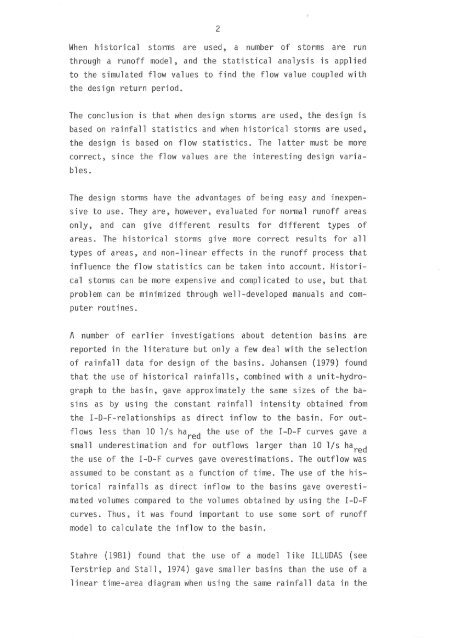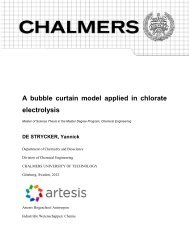Rainfall data for the design of sewer detention basins
Rainfall data for the design of sewer detention basins
Rainfall data for the design of sewer detention basins
Create successful ePaper yourself
Turn your PDF publications into a flip-book with our unique Google optimized e-Paper software.
2<br />
When historical storms are u a number <strong>of</strong> storms are run<br />
through a run<strong>of</strong>f model and stati ical analysis is applied<br />
to <strong>the</strong> simul flow values to find <strong>the</strong> flow value coupled with<br />
<strong>the</strong> ign return period.<br />
The conclusion is that when ign storms are u , <strong>the</strong> <strong>design</strong> is<br />
based on rai 11 statistics and when historical storms are used,<br />
<strong>the</strong> ign is on flow istics The latter must be more<br />
since flow values are <strong>the</strong> ting ign varia<br />
bles<br />
The ign storms have <strong>the</strong> advantages <strong>of</strong> ing easy and inexpen<br />
sive to use They are, however, evaluated <strong>for</strong> normal run<strong>of</strong>f areas<br />
only, and can give di rent results <strong>for</strong> different types <strong>of</strong><br />
areas The historical storms give more correct results <strong>for</strong> all<br />
types <strong>of</strong> areas, and non-linear effects in <strong>the</strong> run<strong>of</strong>f process that<br />
influence <strong>the</strong> flow statistics can be taken into account. Historical<br />
storms can be more expensive and complicated to use, but that<br />
problem can minimized through well-developed manuals and computer<br />
routines<br />
A number <strong>of</strong> earlier investigations about <strong>detention</strong> <strong>basins</strong> are<br />
reported in <strong>the</strong> literature but only a few deal with <strong>the</strong> selection<br />
<strong>of</strong> rainfall <strong>data</strong> <strong>for</strong> <strong>design</strong> <strong>of</strong> <strong>the</strong> <strong>basins</strong>. Johansen (1979) found<br />
that <strong>the</strong> use <strong>of</strong> historical rainfalls, combined with a unit-hydrograph<br />
to <strong>the</strong> basin, gave approximately <strong>the</strong> same sizes <strong>of</strong> <strong>the</strong> <strong>basins</strong><br />
as by using <strong>the</strong> constant rainfall intensity obtained from<br />
<strong>the</strong> I relationships as direct inflow to <strong>the</strong> basin. For outflows<br />
less than 10 1/s hared <strong>the</strong> use <strong>of</strong> <strong>the</strong> I-D-F curves gave a<br />
small underestimation and <strong>for</strong> outflows larger than 10 1/s hared<br />
<strong>the</strong> use <strong>of</strong> <strong>the</strong> I-D-F curves gave overestimations. The outflow was<br />
assumed to be constant as a function <strong>of</strong> time. The use <strong>of</strong> <strong>the</strong> his<br />
torical rainfalls as di inflow to <strong>the</strong> <strong>basins</strong> gave overesti<br />
mated volumes compared to volumes obtained by using <strong>the</strong> I F<br />
curves. Thus, it was found important to use some sort <strong>of</strong> run<strong>of</strong>f<br />
model to calculate <strong>the</strong> inflow to <strong>the</strong> basin.<br />
Stahre (1981) found that <strong>the</strong> use <strong>of</strong> a model like ILLUDAS (see<br />
Terstriep and Stall, 1974) gave smaller <strong>basins</strong> than <strong>the</strong> use <strong>of</strong> a<br />
linear time-area diagram when using <strong>the</strong> same rainfall <strong>data</strong> in <strong>the</strong>















